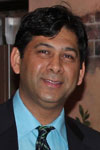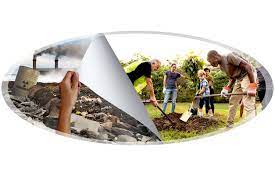News
20242023202220212020
Environmental exposures and Parkinson’s disease: connecting the dots: Interview with Dr. Ray Dorsey and Dr. Rick Woychik (Director of NIEHS)
Monday, December 5, 2022
Dr. Rick Woychik, the Director of the National Institute of Environmental Health Sciences (NIEHS), and Dr. Ray Dorsey spoke about how air pollution, certain pesticides, and other agents may be contributing to rising rates of the disorder.
At this year’s meeting of the American Neurological Association, held in late October, Dr. Woychik helped to moderate a plenary session titled “Neurologic Dark Matter: Exploring the Exposome that Drives Neurological Disorders.” The exposome refers to all of the exposures experienced by an individual throughout life and their corresponding biological effects. Ray Dorsey, M.D., argued that when it comes to causes of Parkinson’s disease, scientists should focus on the role of multiple environmental toxicants, such as air pollution and pesticides, rather than genetics alone.
Read More: Environmental exposures and Parkinson’s disease: connecting the dots: Interview with Dr. Ray Dorsey and Dr. Rick Woychik (Director of NIEHS)Banning Fruity Flavors Did Not Deter Vapers
Wednesday, November 30, 2022
Adults did not quit vaping in response to FDA ban of flavored e-cigarettes
 On February 6, 2020, the U.S. Food and Drug Administration banned the sale of many flavored e-cigarettes, with some important exceptions. According to a survey conducted by University of Rochester Medical Center (URMC) researchers, the ban did not result in adults quitting e-cig use and may have driven some back to smoking regular cigarettes. The researchers point to policy loopholes as the main reasons the policy failed to push people to quit.
On February 6, 2020, the U.S. Food and Drug Administration banned the sale of many flavored e-cigarettes, with some important exceptions. According to a survey conducted by University of Rochester Medical Center (URMC) researchers, the ban did not result in adults quitting e-cig use and may have driven some back to smoking regular cigarettes. The researchers point to policy loopholes as the main reasons the policy failed to push people to quit.
Survey results, published in Tobacco Control, show that less than five percent of the 3,500 adult e-cig users who responded to the survey quit using e-cigs in response to the flavored e-cig ban. The rest of the respondents switched to other forms or flavors of e-cigs not covered by the ban or other types of tobacco products.
“An increasing body of literature shows that e-cig flavors themselves cause damage when inhaled, so it makes sense to ban flavors,” said Deborah J. Ossip, Ph.D., a tobacco research expert and professor in the Department of Public Health Sciences and Center for Community Health and Prevention at URMC who co-authored the study. “But the ban doesn’t appear to be working. People – including youth – can still get flavored products and are still using them.”
Read More: Banning Fruity Flavors Did Not Deter VapersNew Capacity Building Project RFA
Tuesday, November 15, 2022
We’re happy to announce this years Capacity Building Project RFA which is due January 20th, 2023. Please share with colleagues and local community groups.
The University of Rochester Environmental Health Sciences Center (EHSC) Community Engagement Core (CEC) works with community partners to develop science-based solutions to environmental problems. Strong community partnerships are essential to generate, transmit, and use science to help solve environmental health problems. The Capacity Building Project (CBP) program provides funding for local organizations to grow their engagement in environmental health. The EHSC will provide up to $10,000 for one CBP in 2023. Nonprofit organizations are eligible to apply. Projects should address issues of environmental health disparities in the greater Rochester region. Our overall goals are to build community capacity to address local environmental health problems and identify opportunities for future partnerships with the EHSC.
If you have any questions, please contact Cait (Fallone) Sharma.
A One-Two Punch: Low Levels of Coffee Roasting Chemical and Mild Flu May Damage Lungs
Monday, October 10, 2022
We’ve known for two decades that chronic exposure to high levels of a flavoring chemical called diacetyl, which is found in many foods and beverages, can cause lung damage. Now, a University of Rochester Medical Center study suggests that even short-term exposures to this flavoring chemical can damage the lungs of mice when paired with a second insult, like the flu.
Diacetyl, which gives microwave popcorn its buttery flavor, was first linked to flavorings-related lung disease in the early 2000’s when a group of former microwave-popcorn factory workers came down with the illness. More recently, a similar lung disease has been seen among coffee roasters who inhale large concentrations of diacetyl, which is a natural byproduct of the coffee roasting process.
While those workers inhaled high levels of diacetyl over long periods of time, the URMC study published in the American Journal of Physiology – Lung Cellular and Molecular Physiology set out to test whether low-level, short-term exposures to the same chemical could produce a similar effect.
“We found that a single exposure to diacetyl for short periods of time did not result in much lung damage,” said lead study author Matthew D. McGraw, M.D., assistant professor of Pediatric Pulmonology at URMC. “But when mice are exposed to another common environmental exposure, like flu, the double hit can cause airway disease similar to what we see with high-dose, long-term exposures to diacetyl.”
In the study, which was supported by a pilot grant from the URMC Environmental Health Science Center and a Career Development Award from the UR Clinical and Translational Science Institute, mice were exposed to diacetyl for one hour a day over five consecutive days at levels similar to what coffee roasters encounter at work. Mice were then exposed to influenza A, which typically causes seasonal flu in humans.
Within two weeks of exposure, more than half of the mice that received this one-two hit died, while all of the mice in the control groups (exposed to diacetyl alone, flu alone, or neither) survived. Lungs from mice exposed to the ‘two-hits’ showed significant impairment of lung function and airway repair compared to controls.
Researchers then switched the order of exposure, infecting another group of mice with flu first, allowing them to recover for nine days, then exposing them to diacetyl for five days. Whether the mice were exposed to diacetyl before or after flu, their lungs were unable to fully heal, again suggesting that exposure to both chemical and virus leads to abnormal airway repair.
"Our study shows that common environmental exposures that seem harmless on their own can have very serious impacts on lung function and long-term respiratory health when combined," McGraw said.
While further research is needed to understand the impacts of low levels of diacetyl on humans, this study could have implications for people who are exposed to diacetyl at work, like coffee roasters. Currently, McGraw’s team is conducting a study in mice to see how long after a flu infection it is safe to be exposed to diacetyl, which could help inform when coffee roasters can safely return to work after having the flu.
In the near future, the team also plans to collaborate with coffee roasters in our region to spread awareness of the risks of diacetyl exposure, assess existing exposure mitigation procedures, and survey workers for lung disease symptoms.
Other authors of the American Journal of Physiology – Lung Cellular and Molecular Physiology study include Michael A. O’Reilly, Ph.D., professor of Pediatrics; B. Paige Lawrence, Ph.D., chair and professor of Environmental Medicine; Andrew M. Dylag, M.D., associate professor of Pediatrics; Min Yee, a technical associate in the O’Reilly lab; and So-Young Kim, M.S., a technician in the McGraw lab.
This project was supported by a pilot grant from the URMC Environmental Health Science Center under grant number P30 ES001247 from the National Institute of Environmental Health Sciences and by the University of Rochester CTSA award number KL2 TR001999 from the National Center for Advancing Translational Sciences.
Read More: A One-Two Punch: Low Levels of Coffee Roasting Chemical and Mild Flu May Damage LungsUniversity Awards Recipient
Tuesday, June 7, 2022

 Congratulations to Dr. Martha Susiarjo, who received the School of Medicine and Dentistry’s Academic Mentoring Award in Basic Sciences
Congratulations to Dr. Martha Susiarjo, who received the School of Medicine and Dentistry’s Academic Mentoring Award in Basic Sciences
The Leadership Award for Excellence in Equity and Inclusion
Jakob Gunderson (Toxicology)
Dr. Jakob Gunderson studied the mediators and moderators of methylmercury toxicity in the laboratory of Dr. Matthew Rand. During his time at URMC Jakobs worked helped to extend our knowledge on the classically categorized neurotoxicant methylmercury, by uncovering novel targets for the toxicity of MeHg related to the neuromuscular system. Through these efforts Jakob was the recipient of the prestigious Bernard Weiss Toxicology Award for excellence and innovative research in the field of neurotoxicology and published seven manuscripts.
Jakob was also a leader and mentor both in the lab as well as away from the bench, with clear passions for diversity, inclusion, and equity in STEM. Over the course of his graduate career Jakob was instrumental in the creation and initial set of leadership for the Toxicology programs Diversity and Inclusion Group (DIG) where he played a large role in crafting the mission and vision statements that guide the work of the group. Jakob was also involved with the formation of outGRADS where he served as the first secretary, taking on the role of determining the organization and structure of the group.
Irfan Rahman, PhD., Receives American Thoracic Society (ATS) 2022 Recognition Award for Scientific Accomplishment
Monday, April 18, 2022
 Dr. Irfan Rahman has been awarded the 2022 American Thoracic Society’s (ATS) Recognition Award for Scientific Accomplishment in honor of his “outstanding scientific contributions in basic or clinical research to enhance the understanding, prevention and treatment of respiratory disease or critical illness”. Awardees are selected based on outstanding contributions made throughout their careers or for major contributions made at a particular point in their careers, and worthy of the highest recognition the Society can bestow via rigorous selection criteria. In particular, the award is given in recognition and appreciation of Dr. Rahman’s career dedicated to outstanding research and teaching of respiratory diseases, and service to the society and community. Honorees receive a medallion/plaque for Scientific Achievement from the Society presented by the President at the Annual Meeting in San Francisco, CA from May 13-18, 2022.
Dr. Irfan Rahman has been awarded the 2022 American Thoracic Society’s (ATS) Recognition Award for Scientific Accomplishment in honor of his “outstanding scientific contributions in basic or clinical research to enhance the understanding, prevention and treatment of respiratory disease or critical illness”. Awardees are selected based on outstanding contributions made throughout their careers or for major contributions made at a particular point in their careers, and worthy of the highest recognition the Society can bestow via rigorous selection criteria. In particular, the award is given in recognition and appreciation of Dr. Rahman’s career dedicated to outstanding research and teaching of respiratory diseases, and service to the society and community. Honorees receive a medallion/plaque for Scientific Achievement from the Society presented by the President at the Annual Meeting in San Francisco, CA from May 13-18, 2022.
Dr. Rahman stated ‘I am honored for this award. I have been involved in the ATS and its various assemblies including Respiratory Cell Molecular Biology since 1990s since I was a postdoctoral researcher”. I am always interested studying the inhalation toxicity on human lung affecting millions of people worldwide.
Dr. Rahman is a Dean’s Professor of Environmental Medicine, Medicine (Pulmonary), Public Health Sciences and General Dentistry at the University of Rochester Medical Center (School of Medicine and Dentistry), NY., and Director of Flavoring Inhalation Toxicology Center.
Dr. Rahman’s research interests include oxidative stress, inflammation, molecular clock, mitochondrial dysfunction, epigenetics, and cellular senescence by environmental tobacco smoke/tobacco products (cigarette smoke, e-cigarettes, waterpipe/hookah, and cigars) and air pollutants and other toxicants in lung (Chronic Obstructive Pulmonary Disease and idiopathic pulmonary fibrosis), as well as oral/periodontal diseases.
His research is funded by the National Institutes of Health and he is the PD/site PI for the FDA/NCI TCORS U54 and TriState SenNet U54 consortium. He has published over three hundred (300) publications in peer-reviewed journals, and invited to write chapters in medical textbooks and editorials in journals (h-index = 107, i-index 258), total citations 46,558, selected as Highly Cited Researchers, 2014, 2015, and 2016 by Thomson Reuters).
Dr. Rahman has been serving as a member of several panels of National Institutes of Health (NIH) study sections (SIEE, chartered member), served as a chartered member of USA Veterans Administration panel on Pulmonary study section, and chair of California Cardiopulmonary tobacco research program.
He is also recognized internationally and ranked #16 (out of 52,718 active Respiratory & Allergy Researchers) by Ioannidis et al 2020. He is the editor/author of Inflammation, Aging, Diet and Nutrition - a book published by Elsevier in 2013.
Dr. Rahman is an Associate Editor of Nature Scientific Reports, Frontiers in Respiratory Pharmacology, Toxicology and Applied Pharmacology, Journal of Inflammation, and Experimental Lung Research, and past Associate Editor of European Respiratory Journal, International J of COPD. He is a current member of the editorial boards of several international journals, such as Am. J. of Respiratory Cell & Molecular Biology, Therapeutic Advances in Respiratory Disease, Current Respiratory Medicine Reviews, Respiratory Research, and Antioxidants Redox Signaling.
Dr. Rahman is a member of American Thoracic Society (ATS), American Physiological Society, and Society of Toxicology (SOT), and President for Inhalation Respiratory Specialty Section of the SOT 2020-2021, and Chair of Lung Aging Interest Group of the ATS. Dr. Rahman won numerous awards, such as an outstanding Senior Investigator Award by the Oxygen Society of California, USA in 2006, ASIO Senior Toxicologist Award by the SOT in 2017, and International Chemical Society in 2019.
More information of the ATS awards may be found here: https://conference.thoracic.org/program/respiratory-health-awards/
Dr. Deborah Cory-Slechta receives the 2022 Susan B. Anthony Lifetime Achievement Award
Wednesday, April 6, 2022
Congratulations to Dr. Deborah Cory-Slechta, Professor of Environmental Medicine, who is the recipient of the 2022 Susan B. Anthony Lifetime Achievement Award!
The Susan B. Anthony Lifetime Achievement Award, established in 1997 by the Susan B. Anthony Center, honors and celebrates women whose lives have been enriched by their years at the University of Rochester and who have, in turn, inspired other women to advance and lead. Nominees are faculty, staff, trustees and/or alumnae who have achieved significant professional stature and influence, who have a commendable, trailblazing body of work, and who have used their experience and skills to help other women advance as leaders.
Cautious, careful people, always casting about to preserve their reputation and social standing never can bring about reform. Those who are really in earnest must be willing to be anything or nothing in the world’s estimation.– Susan B. Anthony
Dr. Deborah Cory-Slechta and colleagues selected for editor's collection
Friday, March 4, 2022
 A publication by Dr. Deborah Cory-Slechta and colleagues was selected for the Environmental Health Perspectives Editors’ Collection, which spotlights 15 particularly high impact papers from 2021.
A publication by Dr. Deborah Cory-Slechta and colleagues was selected for the Environmental Health Perspectives Editors’ Collection, which spotlights 15 particularly high impact papers from 2021.
Confronting Racism in Environmental Health Sciences: Moving the Science Forward for Eliminating Racial Inequities Environ Health Perspect, 2021 May;129(5):55002.
doi: 10.1289/EHP8186. Devon C Payne-Sturges 1 , Gilbert C Gee 2 , Deborah A Cory-Slechta 3 PMCID: PMC8096378 DOI: 10.1289/EHP8186
Meet Five Inspiring Women in Science
Friday, February 11, 2022
URMC Researchers Reflect on International Day of Women and Girls in Science.
Be curious and inquisitive. Cultivate relationships with mentors. Never limit yourself. Follow your heart.
These are just a few pieces of advice that women researchers from across the University of Rochester Medical Center have for young women and girls interested in science.
Despite progress in recent years, women and girls from around the world are still less likely to enter and advance in science, technology, engineering and math (STEM) fields. According to the United Nations, female researchers are typically awarded smaller research grants, are less likely to have their work published by high-profile journals, and have shorter careers than their male colleagues.
And the COVID pandemic has only exacerbated these disparities as the burden of care in the home fell disproportionately to women.
To combat these disparities, the United Nations General Assembly declared February 11 the International Day of Women and Girls in Science in 2015. Today, we celebrate the work and achievements of women in STEM and promote full and equal access to STEM for women and girls the world over.
Read More: Meet Five Inspiring Women in ScienceDr. Lawrence Spotlighted as URMC Researchers Reflect on International Day of Women and Girls in Science
Friday, February 11, 2022
Be curious and inquisitive. Cultivate relationships with mentors. Never limit yourself. Follow your heart.
These are just a few pieces of advice that women researchers from across the University of Rochester Medical Center have for young women and girls interested in science.
Despite progress in recent years, women and girls from around the world are still less likely to enter and advance in science, technology, engineering and math (STEM) fields. According to the United Nations, female researchers are typically awarded smaller research grants, are less likely to have their work published by high-profile journals, and have shorter careers than their male colleagues.
And the COVID pandemic has only exacerbated these disparities as the burden of care in the home fell disproportionately to women.
To combat these disparities, the United Nations General Assembly declared February 11 the International Day of Women and Girls in Science in 2015. Today, we celebrate the work and achievements of women in STEM and promote full and equal access to STEM for women and girls the world over.
Read More: Dr. Lawrence Spotlighted as URMC Researchers Reflect on International Day of Women and Girls in ScienceKatrina Korfmacher, Ph.D. Featured in Environmental Factor - Your Online Source for NIEHS News
Tuesday, January 4, 2022
Wastewater-based epidemiology comes of age during pandemic
Wastewater sampling provides noninvasive, cost-effective tool for tracking disease prevalence and spread, say experts at NIEHS event.
Katrina Korfmacher, Ph.D., from the University of Rochester, said that at the start of the pandemic, historically disadvantaged communities in upstate New York were disproportionately affected by the virus.
“We thought wastewater monitoring in communities with low testing rates could counteract inequities in the pandemic response by determining where resources were needed,” she said.
A first step was to develop capacity, understanding, and experience within local institutions. So, Korfmacher helped assemble a coalition of local governments and colleges to sample wastewater.
Results from surveillance of student populations allowed colleges to implement strong public health rules, such as closing in-person instruction, without having to track down individual students for testing.
“Wastewater was a valuable part of our overall testing system,” she told attendees.
Read More: Katrina Korfmacher, Ph.D. Featured in Environmental Factor - Your Online Source for NIEHS News